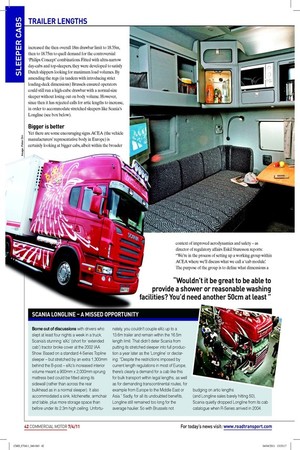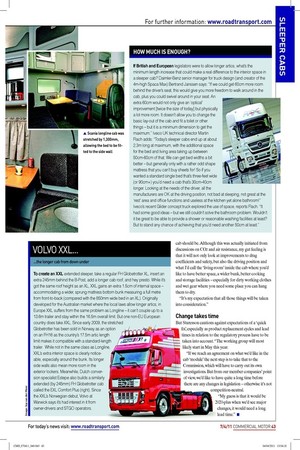Space the
Page 28

Page 29

Page 30

Page 31

If you've noticed an error in this article please click here to report it so we can fix it.
As the DfT consults on longer artics, why shouldn’t drivers have some of the extra room in their cabs? We reckon it’s time to build a bigger box...
Words: Brian Weatherley / Main image: Tom Cunningham If you locked up a convicted criminal in a steel-box measuring 2.5 x 2.3 x 2m there’d be howls of protest from outraged civil rights activists. Yet day in and night out, hundreds of thousands of truck drivers across
Europe live, eat and sleep in the same size box. And as the Department for Transport (DfT) launches a twomonth consultation on longer semi-trailers, it begs the question: if artics up to 18.75m are to be allowed on UK roads, shouldn’t some of that extra space be given to drivers? For Ron Webb, Unite national oficer for road transport commercial, logistics and retail distribution, it’s a no-brainer: “Undoubtedly it should!” And while never a lover of sleeper cabs, Webb adds: “That old debate and opposition to them is now laid to rest – there’s no point resurrecting the dead. Sleeper cabs are a fact of life.” So where might Unite’s quest for bigger cabs lead? “There’s a route to the European Commission [EC] via the European Transport Workers Federation [ETWF],” reckons Webb. “There’s also a route through the H&S Inspectorate without question – and there could be a dotted line to the Working Time Directive around rest periods and making sure people can have a proper rest in proper sleeper cabs.” However, when CM asked the International Road Transport Union (IRU) if it wanted more room in a cab for long-haul truck drivers it told us: “Within the last ive years this question has not been raised by IRU members or by our social partners the European Transport Workers Federation (ETWF) during social dialogue discussions, so we’ve no reason to suspect there’s a particular problem here.”
What about the drivers?
But Webb insists: “The reason they haven’t is because the ETWF has been opposed to longer trailers, and bigger vehicles, particularly in the UK because they know what our policy is.” That policy, continues Webb, is to resist any increase in the current 44-tonne limit and in vehicle lengths – although he also acknowledges: “But if we know they’re deinitely going to bring in longer trailers, we’ve got to say ‘hang on a minute, it’s all right you increasing the capacity for vehicles but what about doing something for the driver?’” URTU general secretary Bob Monks echoes those sentiments. While the union hasn’t previously pushed for bigger sleepers, he says it would be prepared to campaign for larger cabs with more space for drivers, working with other European organisations. “The vexed question of truck parking comes up fairly regularly – but successive Governments don’t do anything about it. With the lack of proper overnight facilities for drivers it’s been inevitable that the prevalence of sleeper cabs has increased over the years, and it would be cloud cuckoo land to think we can get drivers out of them – so anything that can improve the lot of a driver inside their cab has got to be a good thing,” he adds.
The big sleep
A co-ordinated campaign for bigger sleepers would also draw support from the IRU. It says: “As a democratic organisation committed to the interests of its members, we would naturally respond to any commonly endorsed call from our membership.” However, persuading the EC to ‘go long’ for drivers won’t be easy, although there is a precedent. In the mid to late 80s, under strong pressure from the unions, it increased the then overall 18m drawbar limit to 18.35m, then to 18.75m to quell demand for the controversial ‘Philips Concept’ combinations. Fitted with ultra-narrow day-cabs and top-sleepers, they were developed to satisfy Dutch shippers looking for maximum load volumes. By amending the regs (in tandem with introducing strict loading-deck dimensions) Brussels ensured operators could still run a high-cube drawbar with a normal-size sleeper without losing out on body volume. However, since then it has rejected calls for artic lengths to increase, in order to accommodate stretched sleepers like Scania’s Longline (see box below).
Bigger is better
Yet there are some encouraging signs. ACEA (the vehicle manufacturers’ representative body in Europe) is certainly looking at bigger cabs, albeit within the broader context of improved aerodynamics and safety – as director of regulatory affairs Eskil Sturesson reports: “We’re in the process of setting up a working group within ACEA where we’ll discuss what we call a ‘cab module’. The purpose of the group is to deine what dimensions a
cab should be. Although this was actually initiated from discussions on CO2 and air resistance, my gut feeling is that it will not only look at improvements to drag coeficients and safety, but also the driving position and what I’d call the ‘living-room’ inside the cab where you’d like to have better space, a wider bunk, better cooking and storage facilities – especially for dirty working clothes and wet gear where you need some place you can hang them to dry.
“It’s my expectation that all those things will be taken into consideration.”
Change takes time
But Sturesson cautions against expectations of a ‘quick ix’, especially as product replacement cycles and lead times in relation to the regulatory process have to be taken into account. “The working group will most likely start in May this year.
“If we reach an agreement on what we’d like in the cab ‘module’ the next step is to take that to the Commission, which will have to carry out its own investigations. But from our member companies’ point of view, we’d like to have quite a long time before there are any changes in legislation – otherwise it’s not competition-neutral.
“My guess is that it would be 2020-plus when we’d see major changes, it would need a long lead time.” ■

















































